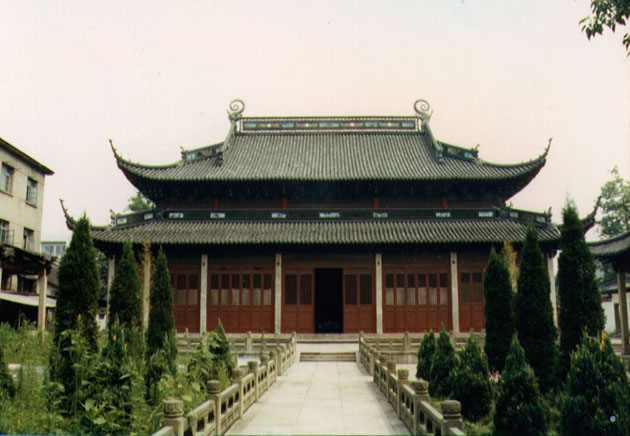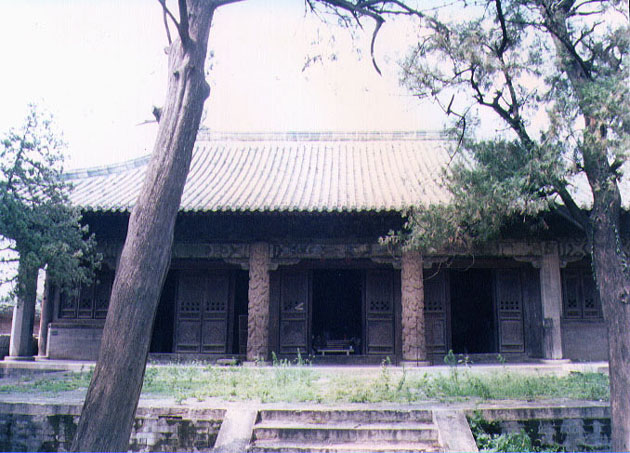

Imperial Confucius Temple in modern-day Hangzhou
169/170 CE (Lingdi jianning 2/3): Beginning of regular Spring and Autumn sacrifices to Kongzi in Qufu, which were modeled after the liturgy of gods of soils and grains.
271 (Jin dynasty, Emperor Wu, Taishi 7): The imperial heir apparent personally offers sacrifices to Kongzi in the National University
445 (Liu-Song dynasty, Emperor Wen yuanjia 22): The first attempt to standardize the Spring and Autumnal sacrifices. Sacrifices use six rows of dancers, three racks of hanging instruments, and the offerings and vessels used are appropriate for an upper lord.
454 (Xiaowudi xiaojian 1/10/15): First temple built outside of Lu, four years after the loss of Lu to Northern Wei
489 CE (Northern Wei dynasty, Emperor Xiaowen taihe 13/7/25): The first temple devoted to Kongzi is constructed in the capital. This is also the first temple built outside of Qufu.
630 (Tang dynasty, Taizong zhenguan 4): Temples are established in prefectural and country state schools
Kongzi received the main offering as sage in the temple of the Tang era and Yan Hui received offerings as correlate. For a short time in the seventh century the Duke of Zhou was placed in the primary position facing south as sage. In 657 the Duke of Zhou was removed and enshrined in the temple for kings of the Zhou dynasty. Also ten of Kongzi's disciples were enshrined as savants for their surpassing virtue in conduct, speech, governance, culture and learning (see Analects 11.3).
647: Twenty-two canonical commentators and exegetes from the Zhou to the Han are enshrined.
720: Seventy of Kongzi's disciples formally enshrined

Qi sheng ci
739 (kaiyuan 27/8/23): Kongzi is elevated to the Exalted King of Culture (previously known as Exalted Ni Duke of Consummate Perfection) and his image seated facing south in temples in the two Directorates of Education
1084: Mengzi (Mencius) is enshrined as a correlate with Yan Hui. Xunzi (Hsun-tzu), Yang Xiong, and Han Yu enshrined as scholars.
1104: Wang Anshi is enshrined as correlate after Mengzi (later demoted to scholar in 1126 and removed entirely in 1241)
1241: The five masters--Zhou Dunyi, Zhang Zai, the Cheng brothers, and Zhu Xi) of the Dao School are enshrined.
1267: Zeng Can (reputed author of the Great Learning) and Kong Ji (reputed author of the Doctrine of the Mean) are promoted to correlates marking the court's recognition of the canonical status of the Four Books. Shao Yong, Sima Guang, and Lu Zuqian are enshrined.
1369 (Ming dynasty, Hongwu 2/): Sacrifices in schools are suspended, but they continue in Qufu.
1372 (Hongwu 5): Sacrifices to Mengzi were suspended but are resumed the following year
1382 (Hongwu 15): The Imperial University resumes sacrifices to Kongzi.
1477 (Chenghua 13/2/8): The number of sacrificial vessels is increased from ten to twelve and the rows of dancers from six to eight. By doing so, Kongzi is effectively promoted to the status of emperor.
1496 (Hongzhi 9/2): The number of dancers is increased again, this time to 72 in accordance with the regulations for the son of Heaven.
1530: The five Song Confucians, including Ouyang Xiu and Lu Xiangshan, are enshrined. Thirteen scholars and canonical exegetes are removed and an additional seven are demoted to local temples. The earlier ranking system based on posthumous titles (king, duke, marquis, earl) is eliminated and the exclusive use of a hierarchy that divided the men enshrined into sage, correlate, and savant (house in the main temple), and worthy and scholar (housed in the eastern and western cloisters) is adopted.

Hall of Good Harvest
1531 (Jiajing 10): The Shrine for the Duke of Giving Birth to the Sage (Kongzi's father)
1642: Six Dao School masters (Zhou Dunyi, the Cheng brothers, Zhang Zai, Shao Yong, and Zhu Xi) are elevated to status of worthy
1712: Zhu Xi is elevated to correlate
1724: Several of the scholars removed in 1530 are restored.
